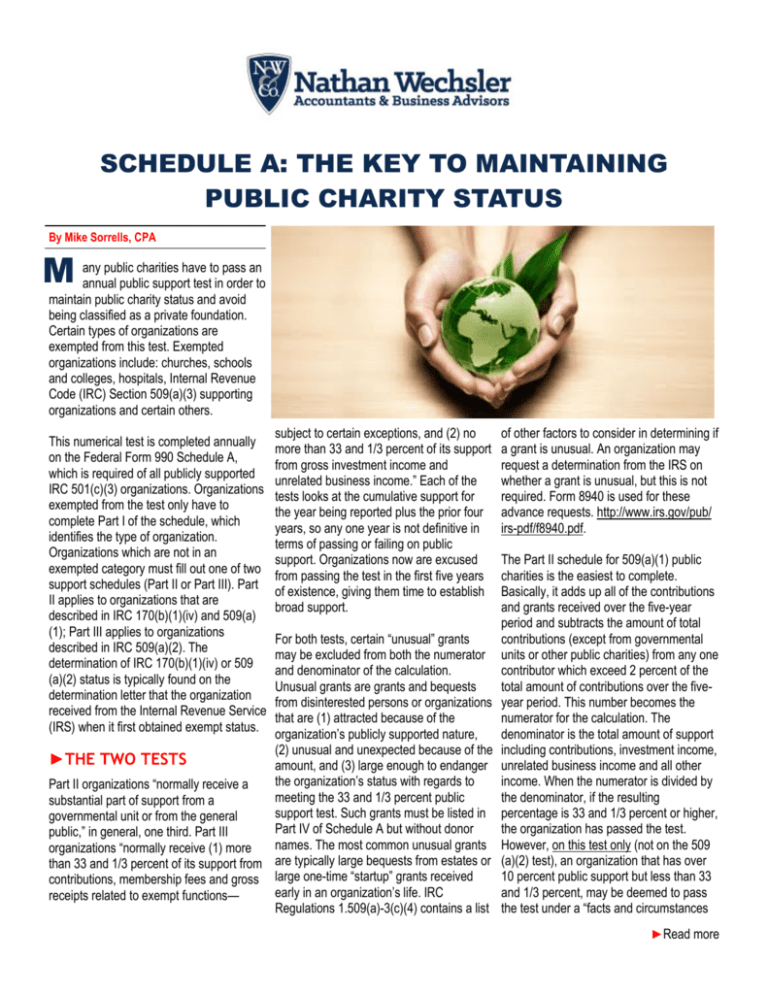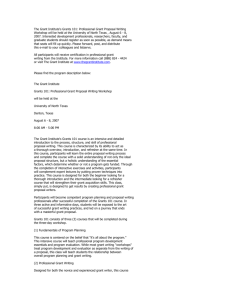
SCHEDULE A: THE KEY TO MAINTAINING
PUBLIC CHARITY STATUS
By Mike Sorrells, CPA
M
any public charities have to pass an
annual public support test in order to
maintain public charity status and avoid
being classified as a private foundation.
Certain types of organizations are
exempted from this test. Exempted
organizations include: churches, schools
and colleges, hospitals, Internal Revenue
Code (IRC) Section 509(a)(3) supporting
organizations and certain others.
This numerical test is completed annually
on the Federal Form 990 Schedule A,
which is required of all publicly supported
IRC 501(c)(3) organizations. Organizations
exempted from the test only have to
complete Part I of the schedule, which
identifies the type of organization.
Organizations which are not in an
exempted category must fill out one of two
support schedules (Part II or Part III). Part
II applies to organizations that are
described in IRC 170(b)(1)(iv) and 509(a)
(1); Part III applies to organizations
described in IRC 509(a)(2). The
determination of IRC 170(b)(1)(iv) or 509
(a)(2) status is typically found on the
determination letter that the organization
received from the Internal Revenue Service
(IRS) when it first obtained exempt status.
subject to certain exceptions, and (2) no
more than 33 and 1/3 percent of its support
from gross investment income and
unrelated business income.” Each of the
tests looks at the cumulative support for
the year being reported plus the prior four
years, so any one year is not definitive in
terms of passing or failing on public
support. Organizations now are excused
from passing the test in the first five years
of existence, giving them time to establish
broad support.
For both tests, certain “unusual” grants
may be excluded from both the numerator
and denominator of the calculation.
Unusual grants are grants and bequests
from disinterested persons or organizations
that are (1) attracted because of the
organization’s publicly supported nature,
(2) unusual and unexpected because of the
►THE TWO TESTS
amount, and (3) large enough to endanger
the organization’s status with regards to
Part II organizations “normally receive a
meeting the 33 and 1/3 percent public
substantial part of support from a
support test. Such grants must be listed in
governmental unit or from the general
Part IV of Schedule A but without donor
public,” in general, one third. Part III
names. The most common unusual grants
organizations “normally receive (1) more
than 33 and 1/3 percent of its support from are typically large bequests from estates or
contributions, membership fees and gross large one-time “startup” grants received
early in an organization’s life. IRC
receipts related to exempt functions—
Regulations 1.509(a)-3(c)(4) contains a list
of other factors to consider in determining if
a grant is unusual. An organization may
request a determination from the IRS on
whether a grant is unusual, but this is not
required. Form 8940 is used for these
advance requests. http://www.irs.gov/pub/
irs-pdf/f8940.pdf.
The Part II schedule for 509(a)(1) public
charities is the easiest to complete.
Basically, it adds up all of the contributions
and grants received over the five-year
period and subtracts the amount of total
contributions (except from governmental
units or other public charities) from any one
contributor which exceed 2 percent of the
total amount of contributions over the fiveyear period. This number becomes the
numerator for the calculation. The
denominator is the total amount of support
including contributions, investment income,
unrelated business income and all other
income. When the numerator is divided by
the denominator, if the resulting
percentage is 33 and 1/3 percent or higher,
the organization has passed the test.
However, on this test only (not on the 509
(a)(2) test), an organization that has over
10 percent public support but less than 33
and 1/3 percent, may be deemed to pass
the test under a “facts and circumstances
►Read more
►Continued from previous page
SCHEDULE A
test” for which it must check a box and
supply the reasons why the facts and
circumstances make the organization a
publicly supported charity. The various
criteria for the facts and circumstances
involved in this assessment are beyond the
scope of this article, but a nonprofit tax
expert can provide these if needed.
When an organization fails the five-year
test two years in a row, it automatically
becomes a private foundation and should
begin filing Form 990-PF.
►PLANNING AND OPTIONS
Obviously, it is important to keep accurate
records of the various numbers that go into
these calculations each year. Before
The Part III schedule is more complex. As
actually failing public support tests, the
mentioned above, it tests for both level of
organization and its advisors should be on
public support and also for level of
alert if public support percentages are
investment and unrelated business income
trending in the wrong direction and should
over the five-year period. For the public
consider ways to gain more public support
support side of this, public support typically
in order to avoid ultimately failing the test
includes contributions and/or grants plus
after five years. Projections can be made
receipts from activities that are not an
for future years to determine approximately
unrelated activity (e.g., membership dues
what is going to be required to pass in the
or program fees). This number is reduced
next several years.
by two different factors: amounts of
contributions and program receipts from
One option for an organization that is
“disqualified persons” and amounts of
trending towards failure or that is failing the
activity fees, etc. from non-disqualified
public support calculation at year-end is to
persons that exceed the greater of $5,000
examine how it would fare if it were utilizing
or 1 percent of total support for each year
the other test. Often an organization, over
in the test. Total support includes all of the
the years, has changed from one that relies
above, plus investment income, unrelated
mostly on donations and grants to one that
business income and all other income.
relies upon a significant amount of program
“Disqualified persons” includes both
revenue (and vice versa). Under current
organization insiders such as officers and
rules, an organization may switch from one
directors and “substantial contributors.” A
test to another without getting permission
full definition of this term is included in the
from the IRS. It must check the box in Part
glossary of terms in the Form 990
I for the other type of organization and then
instructions. Once the numerator is
complete the entire five-year schedule
reduced by both factors, it is then divided
based upon the new type of organization.
by total support to determine if public
This, of course requires digging into past
support is above 33 and 1/3 percent. As
records of donor and program fee amounts
mentioned above, there is no “facts and
and applying the various thresholds to
circumstances” relief for Part III
determine what amounts should be
organizations whose percentage falls
subtracted from the denominator of the
below 33 and 1/3 percent. The other step
calculation.
of the Part III calculation is to divide
investment and unrelated business income
For organizations related to other exempt
by total support. If that result is above 33
organizations, there is the possibility that
and 1/3 percent, then the organization also
they could qualify as a supporting
fails the test.
organization for the other organization and
not have to pass this annual test at all.
Consult a nonprofit tax professional to see
if this is a possibility.
►CONCLUSION
Public support is a very complex
calculation with many nuances and special
rules. But it is of vital importance to every
organization for which it is required.
Organizations and their advisors should (1)
be very careful to determine that this is
being calculated correctly, and (2) keep a
careful eye on the percentage(s) so that
corrective action may be taken before it is
too late.
For more information, contact Kelli D’Amore,
principal, at kdamore@nathanwechsler.com
This article originally appeared in BDO USA, LLP’s “Nonprofit Standard” newsletter (Summer 2014). Copyright © 2014 BDO USA, LLP. All rights
reserved. www.bdo.com






